The AMD Radeon R9 290X Review
by Ryan Smith on October 24, 2013 12:01 AM EST- Posted in
- GPUs
- AMD
- Radeon
- Hawaii
- Radeon 200
Company of Heroes 2
Our second benchmark in our benchmark suite is Relic Games’ Company of Heroes 2, the developer’s World War II Eastern Front themed RTS. For Company of Heroes 2 Relic was kind enough to put together a very strenuous built-in benchmark that was captured from one of the most demanding, snow-bound maps in the game, giving us a great look at CoH2’s performance at its worst. Consequently if a card can do well here then it should have no trouble throughout the rest of the game.
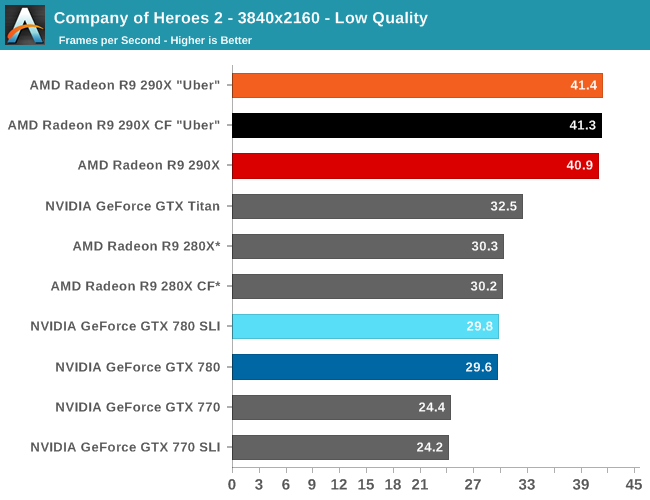
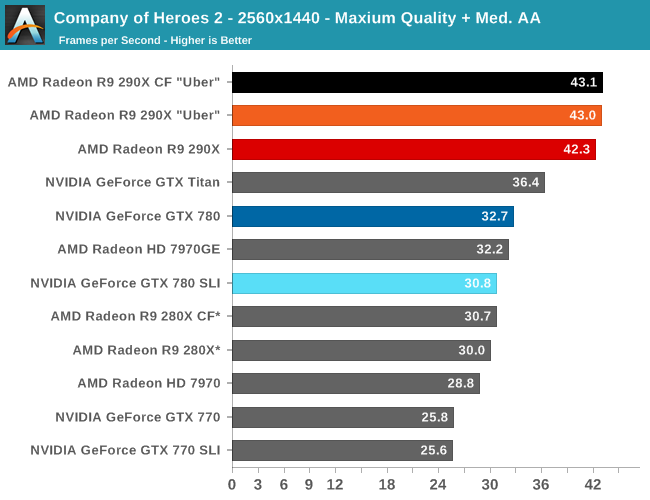
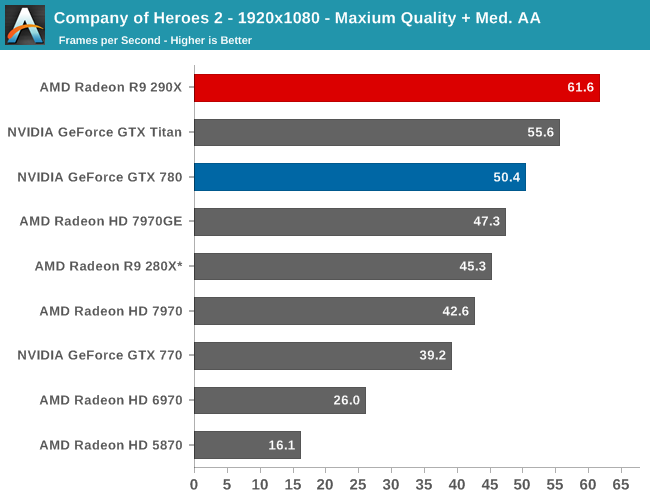
Our first strategy game is also our first game that is flat out AFR incompatible, and as a result the only way to get the best performance out of Company of Heroes 2 is with the fastest single-GPU card available. To that end this is a very clear victory for the 290X, and in fact will be the largest lead for the 290X of all of our benchmarks. At 2560 it’s a full 29% faster than the GTX 780, which all but puts the 290X in a class of its own. This game also shows some of the greatest gains for the 290X over the 280X, with the 290X surpassing its Tahti based predecessor by an equally chart topping 41%. It’s not clear what it is at this time that Company of Heroes 2 loves about 290X in particular, but as far as this game is concerned AMD has put together an architecture that maps well to the game’s needs.
Briefly, because of a lack of AFR compatibility 4K is only barely attainable with any kind of GPU setup. In fact we’re only throwing in the scale-less SLI/CF numbers to showcase that fact. We had to dial down our quality settings to Low on CoH2 in order to get a framerate above 30fps; even though we can be more liberal about playable framerates on strategy games, there still needs to be a cutoff for average framerates around that point. As a result 280X, GTX Titan, and 290X are the only cards to make that cutoff, with 290X being the clear winner. But the loss in quality to make 4K achievable is hardly worth the cost.
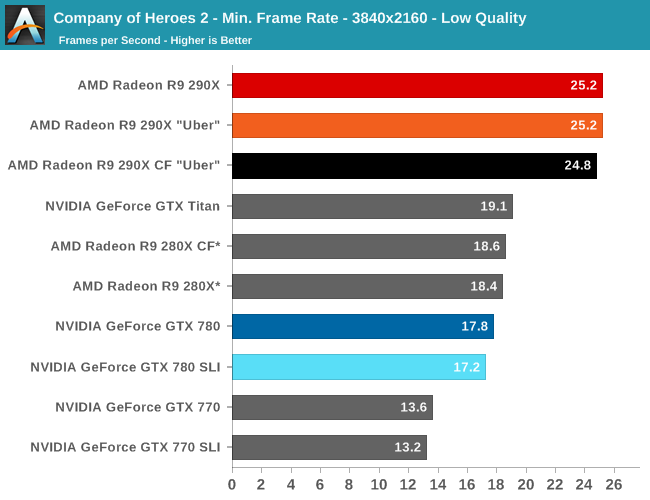
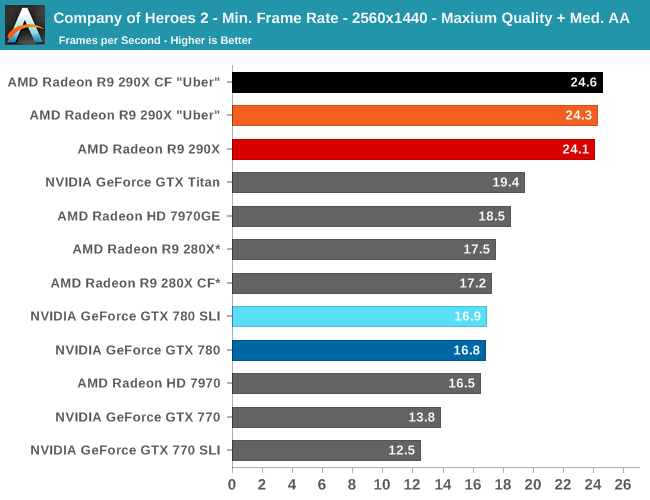

Moving on to minimum framerates, we see that at its most stressful points that nothing, not even 290X, can keep its minimums above 30fps. For a strategy game this is bearable, but we certainly wouldn’t mind more performance. AMD will be pleased though, as their performance advantage over the GTX 780 is only further extended here; a 29% average performance advantage becomes a 43% minimum performance advantage at 2560.
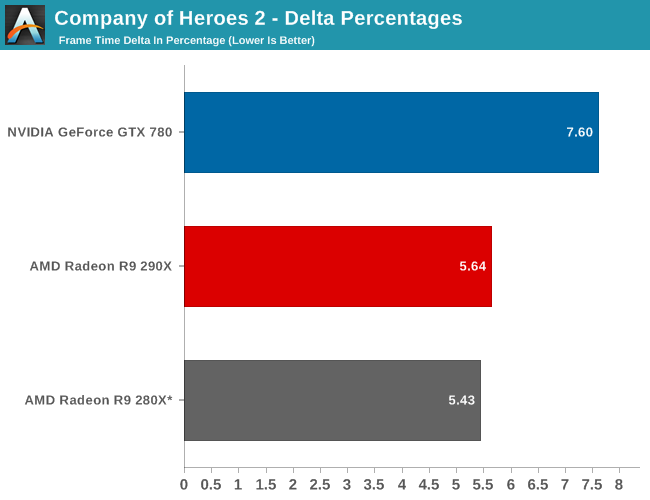
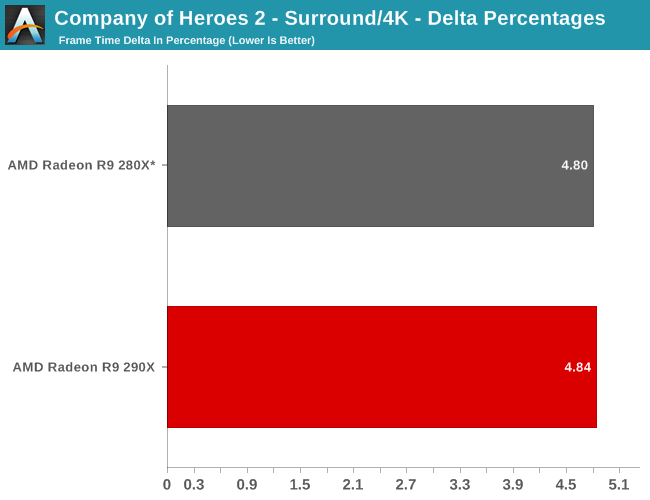
Finally, while we don’t see any performance advantages from AFR on this game we did run our FCAT benchmarks anyhow to quickly capture the delta percentages. Company of Heroes 2 has a higher than average variance even among single cards, which results in deltas being above 5%. The difference between 5% and 7% is not going to be too significant in practice here, but along with AMD’s performance advantage they do have slightly more consistent frame times than the GTX 780. Though in both the case of the 280X and the 290X we’re looking at what are essentially the same deltas, so while the 290X improves on framerates versus the 280X, it doesn’t bring with it any improvements in frame time consistency.










396 Comments
View All Comments
TheJian - Friday, October 25, 2013 - link
Wrong, Zotac price in cart $624. :) Personally I'd buy an OC card for $650 but that's just me.http://www.newegg.com/Product/Product.aspx?Item=N8...
46andtool - Thursday, October 24, 2013 - link
your comment makes no sense, all I see are excuses and misinformation in your post." It doesn't cost less than a GTX780, it only has a lower MSRP." is just stupid, battlefield 4 edition 290xs are already on newegg for $579, the only cheap 780gtxs you will find will be used ones.chrnochime - Thursday, October 24, 2013 - link
What 549? Every 780 on NE goes for 649. I want some of the kool-aid you're drinking.HisDivineOrder - Friday, October 25, 2013 - link
It IS loud. HardOCP have a tendency to be so "hard" they ignore the volume of the card. They aren't the most reliant of sites about the acoustics of a card. Not in the past and not today.JDG1980 - Thursday, October 24, 2013 - link
Regarding 1080p performance, so what? You don't need a $500+ video card to get acceptable frame rates at that resolution. A $200-$300 card will do just fine. $500+ video cards are for multi-monitor setups or high resolution (1440p+) displays.Regarding the noise, that's a problem - AMD clearly stretched things as far as they could go with GCN to reach the current performance level. I know that EK has already announced a 290X waterblock for those enthusiasts who use custom loops. I wouldn't be surprised to see someone come out with a self-contained closed-loop watercooler for the 290X, similar to those that have been available for CPUs for a couple years now. That might help fix the noise issues, especially if it used a dual 120mm/140mm radiator.
46andtool - Thursday, October 24, 2013 - link
we are just now breaking 60fps on 1080p on demanding games at max details, and even more demanding games are just around the corner so your telling people what exactly? And everybody knows AMD makes retarded reference coolers. So another moot point. Lets-try-and -discredit- AMDs- stellar -new product -anyway -we -can- but- the- only- way- we -know -how -is -by -grasping- at- straws.inighthawki - Thursday, October 24, 2013 - link
BS, there's absolutely nothing wrong with a high end card on a 1080p display. Just look at the benchmarks, Crysis 3 1080p on high, a 7970GE barely hits 60fps, and no doubt that will drop below 60 on many occasions (it's just an average). On top of that, not all games are nearly as well optimized as Crytek games, or are just far more complex. Total War: Rome 2, even the 290X doesn't barely hits 60fps on extreme with MEDIUM shadows. Or maybe look at Company of Heroes 2, and how even the 290X hits a min fps of 37fps on extreme.On top of all of that, high resolution IPS panels are super expensive, not everyone cares enough about that to spend the money. The difference between a quality 1080p and a quality 1440p panel can be almost as much as the video card itself.
patrioteagle07 - Thursday, October 24, 2013 - link
Not really... You can find refurbed ZR30s for under $600If you are going to spend 1k on gfx its rather short sighted to keep your TN panels...
inighthawki - Thursday, October 24, 2013 - link
That's at LEAST several hundred dollars more than the majority of people are willing to spend on a monitor. 1080p TN panels are fine for most people, including most gamers. What people care about is not monitor count, pixel count, or color accuracy. They want high quality shaded pixels and good framerate. This is where high end video cards on smaller monitors comes into play. There are plenty of reasons to do it. Do not confuse your own values as the same as what everyone else wants.ShieTar - Friday, October 25, 2013 - link
Also, an increasing number of players is considering 120 FPS to be the acceptable framerate, not 60FPS.